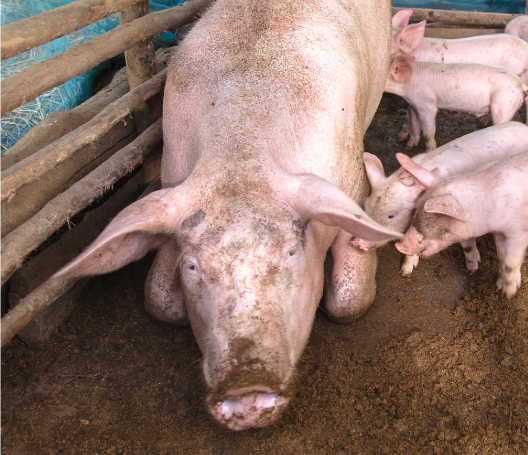Erysipelas – Parvovirosis – Leptospirosis
Control and prevention of these 3 pathogens are key to ensure good reproductive performance in breeding herds worldwide.

Parvovirus (PPV)
Disease
Parvovirosis, caused by porcine parvovirus (PPV), together with Erysipelas and leptospirosis, is one of the main infectious causes of reproductive loss in swine.
During pregnancy it may result in severe reproductive failure. Therefore, control and prevention of diseases associated to this swine pathogen is key to ensure good reproductive performance in breeding herds.
PPV multiplies normally in the intestine of the pig without causing clinical signs. However, it can cause serious reproductive problems in susceptible pregnant females, usually gilts and low parity sows without immunity against the virus.

Economic impact
A shortfall of 678 weaned piglets or 2.26 pigs per sow per year, and a cost of up to US $28,340 ($95 per sow) due to a PPV outbreak in a 300-sow farm has been estimated.1

Prevalence
PPV was detected in 60% of hearts and 61% of tonsils, collected in a German slaughterhouse.2
Thanks to the widespread vaccination in breeding herds, a low PPV prevalence of 6.2% has been recently reported in cases of abortions from Italy.2
Most viruses do not survive outside the host for any great length of time. However, PPV is unusual in that, as it can persist in the environment for many months, and it is resistant to most disinfectants. That is why PPV is widespread distributed and so difficult, if not impossible, to eliminate from swine herds.

Diagnosis
PPV infection is inapparent in all swine except developing foetuses. In susceptible pregnant pigs, predominantly gilts, the virus crosses the placental barrier causing reproductive losses represented by stillbirth, mummification, embryonic death, infertility (SMEDI-syndrome) and delayed return to oestrus. Abortions attributable to this virus are rare.
Key points to recognize parvovirosis:
- Increase in the number of mummified and stillborn piglets.
- Different sizes and degrees of foetal mummification.
- Smaller litter size.
- Infertility and failure to farrow.
- Irregular return to oestrus of mated animals.
When fresh foetal tissues are available, detection of PPV by PCR is the test of choice, as a positive result is highly indicative of PPV being the root cause.
Serum or fluids from foetuses, stillborn piglets, or umbilical cord serum before ingestion of colostrum can also be tested for PP -specific antibodies. Since maternally derived antibodies cannot cross the placental barrier, foetus antibodies are indicative of intrauterine infection.
When foetal tissues are not available, serology in dams may be useful. In this case, paired serum samples should be evaluated, as rising antibody titters in paired acute (at the time of reproductive failure) and convalescent (2-4 weeks later) serum samples are diagnostic.

Treatment and prevention
Control and prevention of PPV are key to ensure good reproductive performance in breeding herds. Control measures should include strict biosecurity, hygiene protocols and vaccination.
- Biosecurity.
- Hygiene, including cleaning and disinfection protocols of all buildings/rooms between batches of pigs. This is especially important for PPV, as it can remain infectious for long time periods, and contaminated.
- Vaccination, to reduce transplacental infection, viral load and foetal mortality.
No herd, irrespective of its health status, is likely to be free of PPV infection and therefore eradication is not possible or very unlikely.
1. Salogni C, et al. Infectious agents identified in aborted swine foetuses in a high-density breeding area: a three-year study. J Vet Diagn Invest. 2016.
2. Streck AF, et al. Analysis of porcine parvoviruses in tonsils and hearts from healthy pigs reveals high prevalence and genetic diversity in Germany. Arch Virol. 2013.
Download the disease infographic
MSD Animal Health solutions to control Erysipelas – Parvovirosis – Leptospirosis

SowCare: Porcilis® Ery+Parvo+Lepto
Porcilis® Ery+Parvo+Lepto is an inactivated vaccine against Porcine parvovirus, Erysipelas disease and Leptospira.
SOLUTIONS
Porcilis® Ery+Parvo+Lepto
Inactivated vaccine against Porcine Parvovirus,
Erysipelas disease and Leptospira.


Onset of immunity after vaccination:
E. rhusiopathiae: 3 weeks
Porcine Parvovirus: 10 weeks
Leptospira serogroups: 2 weeks
Duration of immunity:
E. rhusiopathiae: 6 months
Porcine Parvovirus: 12 months
Leptospira serogroups Australis: 2 weeks
Leptospira serogroups Canicola, Icterohaemorrhagiae, Grippotyphosa, Pomona and Tarassovi: 12 months
BENEFITS
- The broadest protection against Leptospira.a
- The longest combined protection for the 3 pathogens.
- Excellent safety profile.b
- Can be used during pregnancy.c
HOW TO USE IT
- For intramuscular use.
- Administer a single dose of 2 ml in the neck region.
Available in EU, APSA and LATAM
Porcilis® Ery+Parvo+Lepto can be used in mass vaccination.
a. Jacobs, A.A.C., et al. (2015). A novel octavalent combined erysipelas, parvo and Leptospira vaccine provides (cross) protection against infection following challenge of pigs with 9 different Leptospira interrogans serovars. Porcine Health Management 1:16 pp 1-7.
b. Jacobs, A.A.C., et al. (2015). Safety and efficacy of a new octavalent combined erysipelas, parvo and Leptospira vaccine in gilts against L. interrogans serovar Pomona associated disease and foetal death. Vaccine 33 pp 3963-3969.
c. Porcilis® Ery+Parvo+Lepto SPC

SowCare:
Other related vaccines
Porcilis® Ery+Parvo
Porcilis® Ery
Porcilis® Parvo



